There’s a trail in the Payette National Forest not far from my home that has always been a favorite. A few days ago, I got lucky: the morning I decided to run/hike there with the dogs – October 5th – the wildfire smoke that had been blanketing this area cleared out the night before.
The sky at high elevation is more intense, more blue. Worth seeking.

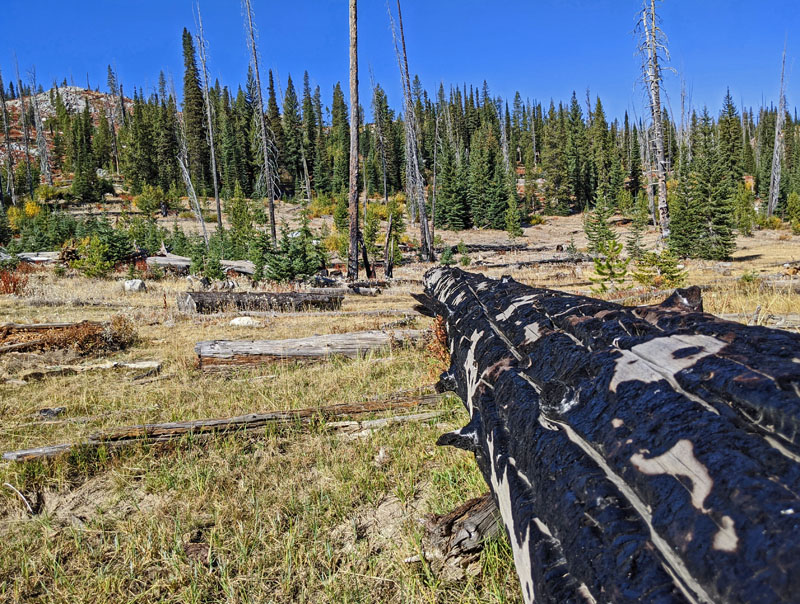

In three miles one climbs 1,738 feet to a seasonally staffed Forest Service fire lookout tower on the summit. After climbing less than a mile an alpine lake comes into view, water level low this late in the year.


Some sections of trail, including near the trailhead at the bottom and close to the fire lookout at the top, are relatively gentle in grade. The middle section through a scree field, however, climbs steeply (44% grade, according to one trail website). My dogs and I run some sections of the trail, others I carefully hike, including the scree section with its loose rocks and obscure path (several small cairns help). Those are really just excuses for me to slow down admire the veins of quartz in the granite at my feet, or to look out across the stunning landscape.
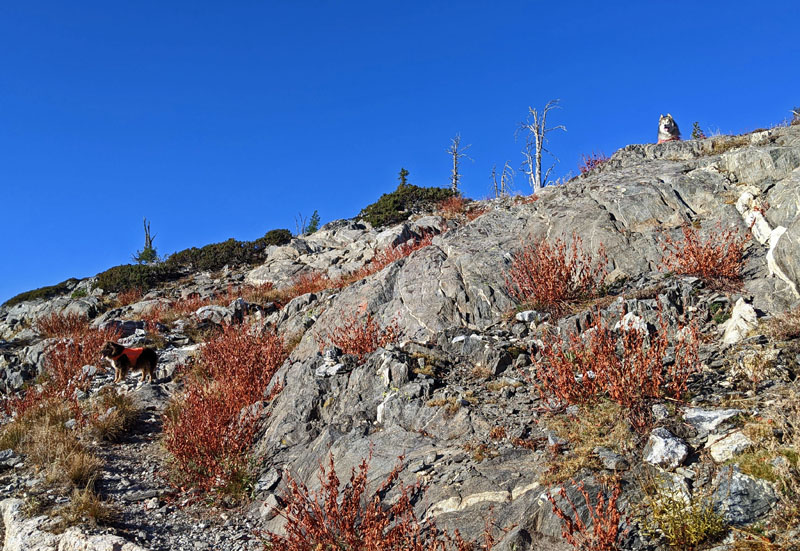

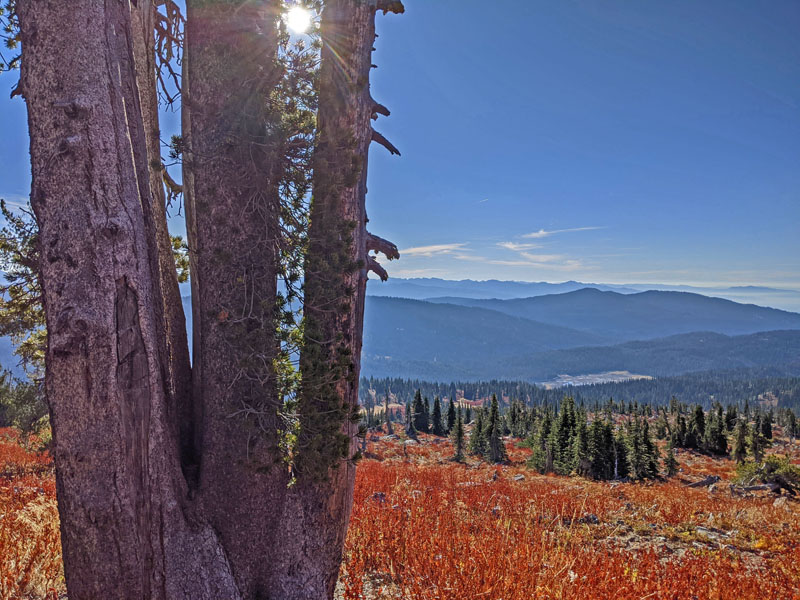
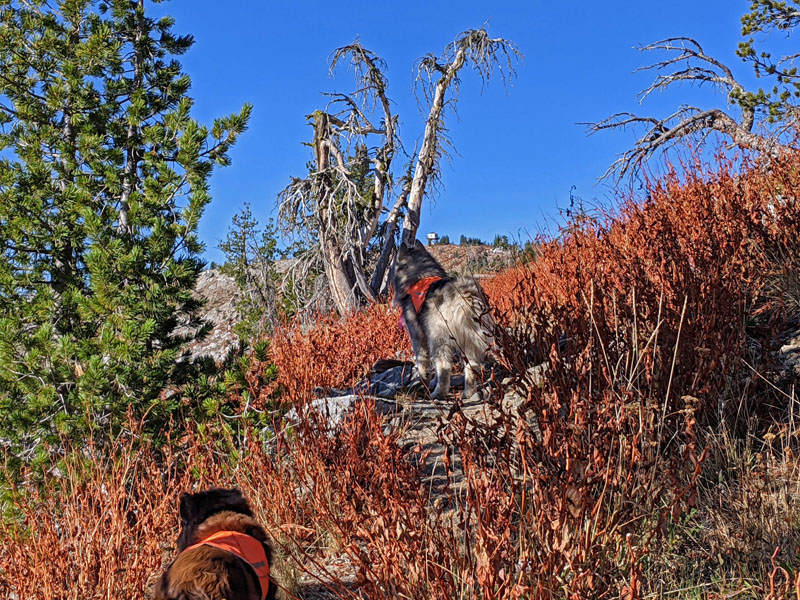
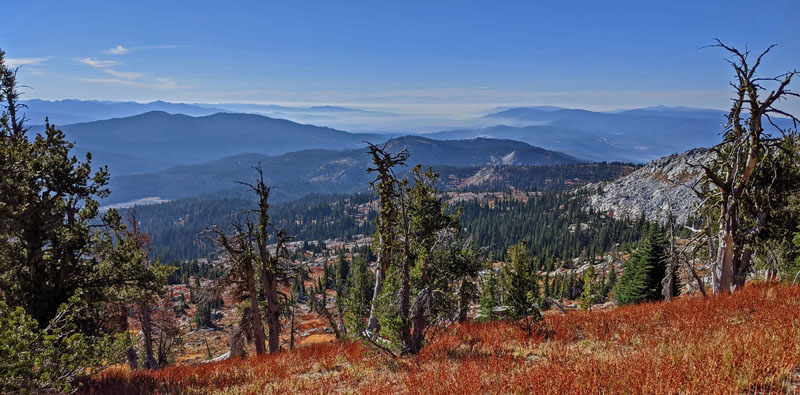

At 8,479 feet in elevation, the views from the summit are amazing, 360-degrees of mountains, forests and river valleys. Definitely worth the effort.


All morning I could see wildfire smoke from a 20,000 acre wildfire roughly 50 miles to the southeast, slowly spreading west, close to the ground. Another smaller wildfire (about 500 acres on that day) 20 miles to the northwest was putting a steady stream of smoke into the air but the breeze sent it directly south, well away from us. The boys and I found ourselves in a sweet spot of clear air between fires. As a bonus, we had the mountain to ourselves, sharing it only with a few birds.
My idea of nirvana.
I always take lots of photos when on this trail.

Did I mention the unique trees? Up here, I get to be close to some majestic whitebark pines (Pinus albicaulis), a relatively rare tree that sadly is becoming more rare. The Forest Service estimates nearly 51% of standing whitebark pines are dead, and that populations will decline 57% by 2100. Two major threats are white pine blister rust and the mountain pine beetle.
Whitebark Pine is a slow-growing, long-lived tree with a life span of up to 500 years and sometimes more than 1,000 years. Although Whitebark Pine can occur in pure or nearly pure stands at high elevations, it more typically occurs in stands of mixed species in a variety of forest community types. Whitebark Pine is considered a keystone or foundation species in western North America where it contributes to critical ecosystem functions.
The seeds are dispersed almost exclusively by Clark’s nutcrackers (Nucifraga columbiana), a jay-like bird of high altitude forest habitats. Consequently, Clark’s nutcrackers facilitate the regeneration of Whitebark Pine and influence its distribution and population structure through their seed caching activities. A single nutcracker can cache up to an estimated 98,000 seeds during a good seed crop year.
U. S. Fish and Wildlife Service
Many of the whitebarks I see here are dead; standing, but bare, no needles. Yet others seem to be thriving. There are also lots of subalpine firs.
When I first moved here, my dogs Maia and Meadow helped me explore this place. A kind lookout employee took photos of us at the summit in July, 2008.

Those happy times with the girls on this mountain compelled me to bring some of their ashes and build a small cairn on the shoulder near the summit to memorialize them after they passed in 2013.

Because the trail is on the east flank of the mountain, exposed to the early sun, I avoid it in July and August – too hot. It’s fun to attempt in early June, when there’s still a lot of snow on the upper reaches. The boys love the snow, eating it whenever they need a sip of water, and I love how pristine everything looks covered in white. We don’t always reach the summit on those early attempts; often the snow is too deep. Soon after most or all of the snow melts – late June, very early July – the wildflowers appear and are gorgeous, although offering less variety than in lower-elevation and less wind-swept sections of the forest.
The mountain is also pretty in autumn, when the leaves of an abundant shrub turn a dark reddish-brown, giving the mountainside at higher elevations the appearance of rusting.
By October it’s cool enough that the boys and I don’t suffer too much from a hot sun. I carry water for the boys to drink at the summit. Heading down is always easier, and offers views not noticed on the way up. Conall loves to get ahead, perching on outcroppings in the scree field, scanning for movement.

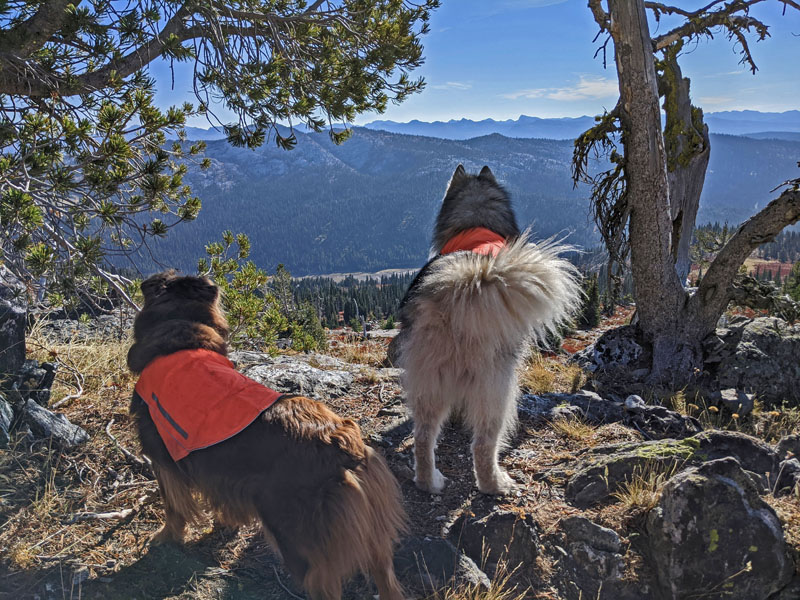

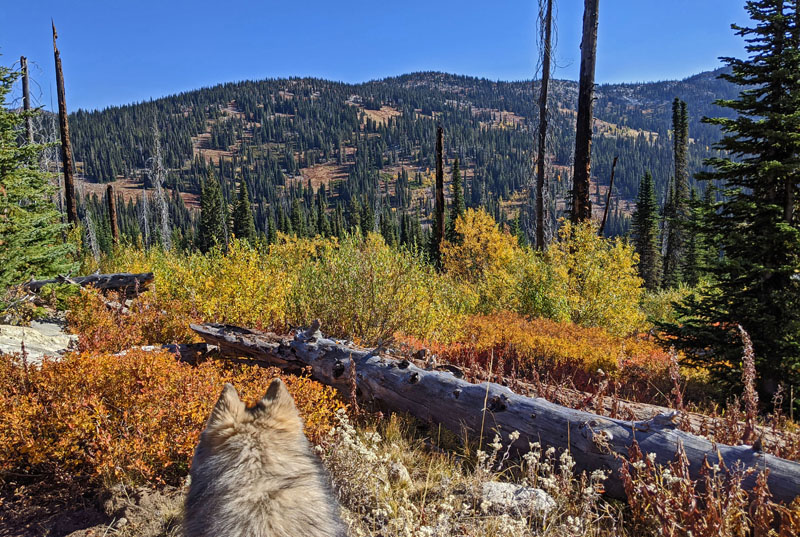


Soon, when there’s a nice dusting of new snow, we’ll head up again. We all love running in fresh snow, and I won’t have to be the boys’ water carrier.
This – easy access to this forest – is why I live here, why I’ve worked hard to create a lifestyle that affords me and my dogs the time and energy to revel in this natural beauty while it’s still here to enjoy. We never take it for granted.


Me and my sore knee envy you that beautiful hike!
LikeLiked by 1 person
Thank you once again for helping us hike vicariously thru your words & pictures. It’s hard work building a house daily, so really enjoy seeing the beautiful trails so nearby and thinking about hiking more again some day soon.
LikeLiked by 1 person
Thanks, Karen! If nothing else, this crazy time of the coronavirus has taught us to not take our health for granted, to experience what we can while we can, eh? I hope you guys can get out, whether hiking or just for strolls across your property to watch the elk.
LikeLike
Lovely – enjoyed the pictures – the views and the words.- makes me feel so tiny.
LikeLiked by 1 person
That’s exactly it, Andy; it makes you feel tiny and insignificant, which maybe we all need to experience more often. Might help us realize we’re part of a delicate system we don’t really understand, rather than somehow in control of. For me, being up there without any other people is the best, no voices, no clanking of hiking poles striking the ground. Just nature’s sounds and my own breath (and that of my dogs) as I scan the horizons. Sometimes it’s hard to leave!
LikeLiked by 1 person
Looks like a great hike. An overall 11% grade with a 44% section would make it a real puffer. But you’re right – what a view!
LikeLiked by 1 person
It’s pretty spectacular on a sunny day. I’ve been up there in November when it’s mixed snow/rain coming at you sideways on a stiff wind; no view, and damn cold! We made a fast retreat that day 🙂
LikeLike
There are hikes and then there is what you guys have, which is a blessing in so many ways. To understand nature so intimately, it’s what I call a blessing.
LikeLiked by 1 person
It is, and I’m forever grateful to have easy access.
I’ve noticed, over this summer of aloneness (which, as an introvert, doesn’t bother me as much as most), that when I’m out in the forest I’m paying much closer attention to the ground I cover and what’s going on right around me. Whitebark trees are a case in point. I’ve passed by them countless times over the years, and beyond noting their coolness, never thought to ask, “What type of tree is this? How does it survive up here?” Wildflowers were more my thing. After that most recent outing, I decided to finally answer those questions about the trees and was blown away to learn how rare and old they are.
The best part is that the stuff one can learn is infinite. You just have to start asking questions 🙂
I only wish my father were still around. Oh, the conversations he and I would have about all this!
LikeLiked by 3 people
Yeah, I’m not bothered by this at all really. It IS my normal, so it’s more a matter of the vibe I feel off of others inside this time. If I hone in too closely on the energy of others, I get depressed as all get out. But aside from that, business as usual.
Interestingly, when I go on hikes I always try to immerse myself in the steps. Open my ears and eyes and just take in the sights and sounds that are usually on automatic pilot.
LikeLiked by 1 person
Very beautiful.
LikeLiked by 1 person
It is a beautiful place! And never fails to inspire.
LikeLiked by 1 person
That does remind me of some of the mountain hikes out here. Even within a couple hours of LA there are lonely windswept mountain tops that can go fir days without a human footfall. They are just a PITA to get to.
LikeLiked by 1 person
I find that sort of solitude worth the PITA drive 🙂
LikeLiked by 1 person
Even in death there’s beauty. I used to envy your lifestyle. Now I’m living a dream of my own. We are currently near the ocean out of necessity, but I hear the mountains calling me back. I’ll heed that call soon. Thanks for the views!
LikeLiked by 1 person
You guys are covering some territory! You might have to wait until 2021 for the mountains; snow will be flying soon…
LikeLike
I’d love to paddle around that lake. It looks so idyllic. Do you ever go canoeing or kayaking? It can be a great way to see wildlife, especially birds.
LikeLiked by 1 person
It is a pretty spot, popular for fishing. Thankfully only non-motorized boats are allowed, keeping it idyllic. Lots of campsites along one side.
I grew up on a lake in western Washington, with access to all sorts of boats, which might explain why boating isn’t a high priority to me as an adult? I only dabbled in canoeing, which always felt a little too tippy to me. I did get to play with a flat water kayak on a nearby lake a couple years ago, and that was fun. As you note, it was a delightful way to watch wildlife. I had hoped to see a moose – that particular river connecting two lakes is known as a favorite haunt for them – but wasn’t so lucky.
LikeLiked by 1 person
I did a lot of canoeing in my teenage years. For my parents, being in nature meant being on the water, either a lake or a river. Maybe because of that familiarity, I don’t feel so drawn to it now. But when I make the effort, it’s worth it. Boats give you a different perspective, and give you access to really cool ecosystems like marshes and swamps. Talking about it makes me want to do it, but I probably won’t. It takes effort! 😀
LikeLiked by 1 person
Some beautiful images and interesting thoughts in your last few posts Rebecca. I loved the hapless Praying Mantis, especially when she decided to attack 🙂
LikeLiked by 1 person
Thank you, Andrea. I appreciate your input, especially as I work up the nerve to start work on a book that will focus on some of these themes.
My mantis friend sure moved fast when she wanted to, startling me! Made me feel like a scuzzy paparazzi, letting me know she’s had enough with the camera closeups invading her space 🙂
LikeLike
Good luck with the book!
LikeLiked by 1 person
Pretty trail… 45 degree incline?
LikeLiked by 1 person
Apparently, in one brief spot (incline, slope and grade all meaning the same thing in this instance). Here’s a link to someone’s trip report showing their stats, including percent grade, both average and maximum. https://www.hikingproject.com/trail/7028457/granite-mountain-lookout
LikeLike
Damn, that is a blue sky.
LikeLiked by 1 person
Right?
Always takes my breath away.
LikeLiked by 1 person